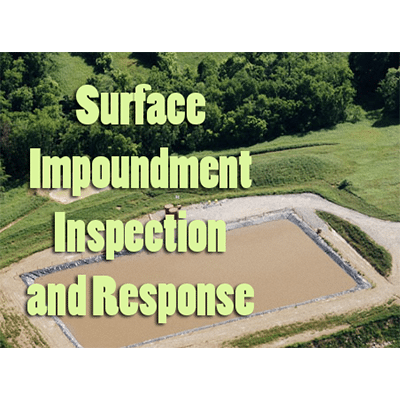
Last week we talked about the design and operation requirements for surface impoundments. Today we’re going to continue on that topic by covering the inspection and response actions that must be completed by surface impoundment operators. In case you’ve forgotten, surface impoundments are a lot like landfill cells. The main difference being that surface impoundments are used for temporary storage or treatment and a landfill cell is designated for final waste disposal.
What are the Inspection Requirements for Surface Impoundments?
To start, we must note that these inspection requirements must be completed in conjunction with the general inspection requirements in §264/265.226. The first additional requirement deals with design and structural integrity of the land disposal unit. According to the EPA, “the owner and operator must inspect liners and covers for any problems after construction or installation and continue inspections weekly and after storms to monitor for evidence of deterioration, malfunctions, improper operation of overtopping systems, sudden drops in the level of the impoundment contents, and severe erosions of dikes and other containment devices.”
The second additional requirement addresses leak detection sumps. According to this rule, on a minimum of a weekly basis owners and operators of land disposal units like surface impoundments must monitor their leak detection sumps in order to measure the amount of liquid within them and to determine whether or not the action leakage rate (ALR) has been exceeded. Doing so makes sure that both the liner and the leachate pump are working efficiently. If owners or operators discover that the ALR has been exceeded they must notify the Agency and respond “in accordance with the response action plan.”
What Response Actions must Surface Impoundments comply with?
Much like the inspection requirements, surface impoundments must also comply with two types of response actions. According to the EPA, “the response action for the performance of the unit is determined by the terms of the response action plan, triggered when the ALR has been exceeded (§264/265.223). If the action leakage rate has been exceeded, the owner and operator must notify the Regional Administrator or authorized state; determine what short-term actions must be taken (e.g., shut down of the facility for repairs); determine the location, size, and cause of any leak; and send the assessments to the Region or authorized state.”
The other response action deals with emergency repair provisions in the case of a unit design failure at permitted facilities. The EPA specifies that “if there is an indication of a failure of the containment system (e.g., a sudden drop in the level of the contents not attributable to changes in the flow in or out of the impoundment), the surface impoundment must be removed from service.” If this happens the owners and operators of the surface impoundment must follow the plans laid out in the contingency plan. This would include any emergency repairs that need to be made.
Quoted and EPA cited information (unless otherwise noted) for this blog post was gathered from the EPA document, “Introduction to Land Disposal Units.” As always, this blog post is not intended to be comprehensive and it is always best to check with the EPA and local government for full, up-to-date, rules and regulations.
More News From Heritage
-
3/7/25
Celebrating Our Team: Employee Appreciation Shoutouts
Learn about how we celebrated Employee Appreciation Day
-
3/6/25
Accelerating Action: Celebrating International Women’s Day
Learn about how we're celebrating International Women's Day
-
2/21/25
Heritage Announces East Liverpool, Ohio 2025 Environmental Grant Program
Learn about our East Liverpool Ohio grant opportunity!
-
2/18/25
Heritage Environmental Services Announces James (Shelby) Marlow as Chief Financial Officer
Heritage Environmental Services announced today that James (Shelby) Marlow will join the organization as Chief Financial Officer.
-
1/31/25
January Community Engagement Initiative: Home/Work Energy Reduction
Learn about our January community engagement initiative
-
1/29/25
Heritage Environmental Services Announces Chris Ebeling as Chief Commercial Officer
Heritage Environmental Services announced today that Chris Ebeling will join the organization as Chief Commercial Officer.
-
1/28/25
Heritage Environmental Services Addresses Industry Challenges with New State-of-the-Art Shredder
Heritage Environmental Services announced a new state-of-the-art shredding unit.
-
1/7/25
Navigating e-Manifest: What You Need to Know About Hazardous Waste Compliance
Learn about the e-Manifest Third Rule changes that begin January 22, 2025







